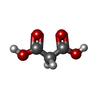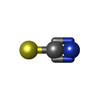+ データを開く
データを開く
- 基本情報
基本情報
| 登録情報 | データベース: PDB / ID: 4z9s | ||||||
|---|---|---|---|---|---|---|---|
| タイトル | Non-covalent assembly of monoubiquitin that mimics K11 poly-ubiquitin | ||||||
 要素 要素 | Ubiquitin-40S ribosomal protein S27a | ||||||
 キーワード キーワード | CELL CYCLE | ||||||
| 機能・相同性 |  機能・相同性情報 機能・相同性情報Translation initiation complex formation / Formation of the ternary complex, and subsequently, the 43S complex / Ribosomal scanning and start codon recognition / Translesion synthesis by REV1 / Recognition of DNA damage by PCNA-containing replication complex / Translesion Synthesis by POLH / Downregulation of ERBB4 signaling / Spry regulation of FGF signaling / Downregulation of ERBB2:ERBB3 signaling / NOD1/2 Signaling Pathway ...Translation initiation complex formation / Formation of the ternary complex, and subsequently, the 43S complex / Ribosomal scanning and start codon recognition / Translesion synthesis by REV1 / Recognition of DNA damage by PCNA-containing replication complex / Translesion Synthesis by POLH / Downregulation of ERBB4 signaling / Spry regulation of FGF signaling / Downregulation of ERBB2:ERBB3 signaling / NOD1/2 Signaling Pathway / APC/C:Cdc20 mediated degradation of Cyclin B / APC-Cdc20 mediated degradation of Nek2A / EGFR downregulation / TCF dependent signaling in response to WNT / NRIF signals cell death from the nucleus / p75NTR recruits signalling complexes / NF-kB is activated and signals survival / Activated NOTCH1 Transmits Signal to the Nucleus / Downregulation of TGF-beta receptor signaling / TGF-beta receptor signaling in EMT (epithelial to mesenchymal transition) / Downregulation of SMAD2/3:SMAD4 transcriptional activity / SMAD2/SMAD3:SMAD4 heterotrimer regulates transcription / Senescence-Associated Secretory Phenotype (SASP) / Regulation of innate immune responses to cytosolic DNA / activated TAK1 mediates p38 MAPK activation / JNK (c-Jun kinases) phosphorylation and activation mediated by activated human TAK1 / Regulation of FZD by ubiquitination / N-glycan trimming in the ER and Calnexin/Calreticulin cycle / Regulation of TNFR1 signaling / TNFR1-induced NF-kappa-B signaling pathway / Translesion synthesis by POLK / Translesion synthesis by POLI / Regulation of necroptotic cell death / HDR through Homologous Recombination (HRR) / Josephin domain DUBs / Recruitment and ATM-mediated phosphorylation of repair and signaling proteins at DNA double strand breaks / Processing of DNA double-strand break ends / Gap-filling DNA repair synthesis and ligation in GG-NER / Dual Incision in GG-NER / Fanconi Anemia Pathway / Regulation of TP53 Activity through Phosphorylation / Regulation of TP53 Degradation / Regulation of TP53 Activity through Methylation / Negative regulation of MET activity / PTK6 Regulates RTKs and Their Effectors AKT1 and DOK1 / Downregulation of ERBB2 signaling / E3 ubiquitin ligases ubiquitinate target proteins / Regulation of PTEN localization / ER Quality Control Compartment (ERQC) / Regulation of expression of SLITs and ROBOs / Interferon alpha/beta signaling / Endosomal Sorting Complex Required For Transport (ESCRT) / Activation of IRF3, IRF7 mediated by TBK1, IKKε (IKBKE) / IKK complex recruitment mediated by RIP1 / IRAK2 mediated activation of TAK1 complex / TRAF6-mediated induction of TAK1 complex within TLR4 complex / Alpha-protein kinase 1 signaling pathway / RAS processing / Pexophagy / Negative regulation of FLT3 / IRAK2 mediated activation of TAK1 complex upon TLR7/8 or 9 stimulation / Regulation of NF-kappa B signaling / Regulation of TBK1, IKKε (IKBKE)-mediated activation of IRF3, IRF7 / Regulation of pyruvate metabolism / SCF-beta-TrCP mediated degradation of Emi1 / MAP3K8 (TPL2)-dependent MAPK1/3 activation / Ovarian tumor domain proteases / Cyclin D associated events in G1 / Regulation of BACH1 activity / Negative regulation of FGFR1 signaling / Negative regulation of FGFR2 signaling / Negative regulation of FGFR3 signaling / Negative regulation of FGFR4 signaling / Negative regulation of MAPK pathway / Formation of Incision Complex in GG-NER / Synthesis of active ubiquitin: roles of E1 and E2 enzymes / Inactivation of CSF3 (G-CSF) signaling / Termination of translesion DNA synthesis / Iron uptake and transport / Negative regulators of DDX58/IFIH1 signaling / Deactivation of the beta-catenin transactivating complex / Metalloprotease DUBs / Major pathway of rRNA processing in the nucleolus and cytosol / GTP hydrolysis and joining of the 60S ribosomal subunit / Formation of TC-NER Pre-Incision Complex / Dual incision in TC-NER / Gap-filling DNA repair synthesis and ligation in TC-NER / Autodegradation of Cdh1 by Cdh1:APC/C / APC/C:Cdc20 mediated degradation of Securin / APC/C:Cdh1 mediated degradation of Cdc20 and other APC/C:Cdh1 targeted proteins in late mitosis/early G1 / Cdc20:Phospho-APC/C mediated degradation of Cyclin A / Autodegradation of the E3 ubiquitin ligase COP1 / Asymmetric localization of PCP proteins / Degradation of AXIN / Degradation of DVL / Hedgehog ligand biogenesis / Hedgehog 'on' state / TNFR2 non-canonical NF-kB pathway / Assembly of the pre-replicative complex / CDK-mediated phosphorylation and removal of Cdc6 類似検索 - 分子機能 | ||||||
| 生物種 |  | ||||||
| 手法 |  X線回折 / X線回折 /  分子置換 / 解像度: 2.3 Å 分子置換 / 解像度: 2.3 Å | ||||||
 データ登録者 データ登録者 | Levin-Kravets, O. / Prag, G. | ||||||
| 資金援助 | 1件
| ||||||
 引用 引用 |  ジャーナル: Biochemistry / 年: 2015 ジャーナル: Biochemistry / 年: 2015タイトル: Tetrameric Assembly of Monoubiquitin Accurately Mimics the Lys11 Polyubiquitin Chain Structure. 著者: Levin-Kravets, O. / Shohat, N. / Prag, G. #1:  ジャーナル: Nat.Struct.Mol.Biol. / 年: 2010 ジャーナル: Nat.Struct.Mol.Biol. / 年: 2010タイトル: Lys11-Linked Ubiqutin Chains Adopt Compact Conformations And Are By The Deubiqutinase Cazannepreferentially Hydrolyzed 著者: Bremm, A. / Freund, S.M.V. / Komander, D. #2:  ジャーナル: J Mol Biol / 年: 1987 ジャーナル: J Mol Biol / 年: 1987タイトル: Structure of ubiquitin refined at 1.8 A resolution. 要旨: The crystal structure of human erythrocytic ubiquitin has been refined at 1.8 A resolution using a restrained least-squares procedure. The crystallographic R-factor for the final model is 0.176. Bond ...The crystal structure of human erythrocytic ubiquitin has been refined at 1.8 A resolution using a restrained least-squares procedure. The crystallographic R-factor for the final model is 0.176. Bond lengths and bond angles in the molecule have root-mean-square deviations from ideal values of 0.016 A and 1.5 degrees, respectively. A total of 58 water molecules per molecule of ubiquitin are included in the final model. The last four residues in the molecule appear to have partial occupancy or large thermal motion. The overall structure of ubiquitin is extremely compact and tightly hydrogen-bonded; approximately 87% of the polypeptide chain is involved in hydrogen-bonded secondary structure. Prominent secondary structural features include three and one-half turns of alpha-helix, a short piece of 3(10)-helix, a mixed beta-sheet that contains five strands, and seven reverse turns. There is a marked hydrophobic core formed between the beta-sheet and alpha-helix. The molecule features a number of unusual secondary structural features, including a parallel G1 beta-bulge, two reverse Asx turns, and a symmetrical hydrogen-bonding region that involves the two helices and two of the reverse turns. | ||||||
| 履歴 |
|
- 構造の表示
構造の表示
| 構造ビューア | 分子:  Molmil Molmil Jmol/JSmol Jmol/JSmol |
|---|
- ダウンロードとリンク
ダウンロードとリンク
- ダウンロード
ダウンロード
| PDBx/mmCIF形式 |  4z9s.cif.gz 4z9s.cif.gz | 83 KB | 表示 |  PDBx/mmCIF形式 PDBx/mmCIF形式 |
|---|---|---|---|---|
| PDB形式 |  pdb4z9s.ent.gz pdb4z9s.ent.gz | 64.7 KB | 表示 |  PDB形式 PDB形式 |
| PDBx/mmJSON形式 |  4z9s.json.gz 4z9s.json.gz | ツリー表示 |  PDBx/mmJSON形式 PDBx/mmJSON形式 | |
| その他 |  その他のダウンロード その他のダウンロード |
-検証レポート
| 文書・要旨 |  4z9s_validation.pdf.gz 4z9s_validation.pdf.gz | 472.8 KB | 表示 |  wwPDB検証レポート wwPDB検証レポート |
|---|---|---|---|---|
| 文書・詳細版 |  4z9s_full_validation.pdf.gz 4z9s_full_validation.pdf.gz | 479 KB | 表示 | |
| XML形式データ |  4z9s_validation.xml.gz 4z9s_validation.xml.gz | 15.4 KB | 表示 | |
| CIF形式データ |  4z9s_validation.cif.gz 4z9s_validation.cif.gz | 21.6 KB | 表示 | |
| アーカイブディレクトリ |  https://data.pdbj.org/pub/pdb/validation_reports/z9/4z9s https://data.pdbj.org/pub/pdb/validation_reports/z9/4z9s ftp://data.pdbj.org/pub/pdb/validation_reports/z9/4z9s ftp://data.pdbj.org/pub/pdb/validation_reports/z9/4z9s | HTTPS FTP |
-関連構造データ
| 関連構造データ | 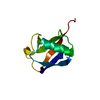 1ubqS S: 精密化の開始モデル |
|---|---|
| 類似構造データ |
- リンク
リンク
- 集合体
集合体
| 登録構造単位 | 
| ||||||||||||
|---|---|---|---|---|---|---|---|---|---|---|---|---|---|
| 1 |
| ||||||||||||
| 単位格子 |
| ||||||||||||
| Components on special symmetry positions |
|
- 要素
要素
| #1: タンパク質 | 分子量: 8576.831 Da / 分子数: 4 / 断片: UNP RESIDUES 1-76 / 由来タイプ: 組換発現 / 由来: (組換発現)   #2: 化合物 | ChemComp-MLA / #3: 化合物 | ChemComp-SCN / #4: 水 | ChemComp-HOH / | |
|---|
-実験情報
-実験
| 実験 | 手法:  X線回折 / 使用した結晶の数: 1 X線回折 / 使用した結晶の数: 1 |
|---|
- 試料調製
試料調製
| 結晶 | マシュー密度: 2.23 Å3/Da / 溶媒含有率: 44.78 % |
|---|---|
| 結晶化 | 温度: 292 K / 手法: 蒸発脱水法 / pH: 4 詳細: 3.4M SODIUM MALONATE, 0.1 M SODIUM THIOSUCCINATE PH4.0, VAPOR DIFFUSION, SITTING DROP, TEMPERATURE 292K PH範囲: 4 |
-データ収集
| 回折 | 平均測定温度: 100 K |
|---|---|
| 放射光源 | 由来:  回転陽極 / タイプ: RIGAKU / 波長: 1.5418 Å 回転陽極 / タイプ: RIGAKU / 波長: 1.5418 Å |
| 検出器 | タイプ: RIGAKU RAXIS IV++ / 検出器: IMAGE PLATE / 日付: 2008年12月25日 |
| 放射 | プロトコル: SINGLE WAVELENGTH / 単色(M)・ラウエ(L): M / 散乱光タイプ: x-ray |
| 放射波長 | 波長: 1.5418 Å / 相対比: 1 |
| 反射 | 解像度: 2.3→49.75 Å / Num. obs: 13167 / % possible obs: 99.9 % / Observed criterion σ(I): 0 / 冗長度: 5.9 % / Rmerge(I) obs: 0.047 / Net I/σ(I): 16.6 |
| 反射 シェル | 冗長度: 5.8 % / Rmerge(I) obs: 0.147 / Mean I/σ(I) obs: 7.3 / % possible all: 100 |
- 解析
解析
| ソフトウェア |
| ||||||||||||||||||||
|---|---|---|---|---|---|---|---|---|---|---|---|---|---|---|---|---|---|---|---|---|---|
| 精密化 | 構造決定の手法:  分子置換 分子置換開始モデル: PDB ENTRY 1UBQ 解像度: 2.3→24.57 Å / SU B: 7.693 / SU ML: 0.187 / 交差検証法: THROUGHOUT / ESU R: 0.472 / ESU R Free: 0.264 / 立体化学のターゲット値: MAXIMUM LIKELIHOOD / 詳細: HYDROGENS HAVE BEEN ADDED IN THE RIDING POSITIONS
| ||||||||||||||||||||
| 溶媒の処理 | イオンプローブ半径: 0.8 Å / 減衰半径: 0.8 Å / VDWプローブ半径: 1.4 Å / 溶媒モデル: MASK | ||||||||||||||||||||
| 原子変位パラメータ | Biso mean: 23.26 Å2
| ||||||||||||||||||||
| 精密化ステップ | サイクル: LAST / 解像度: 2.3→24.57 Å
| ||||||||||||||||||||
| LS精密化 シェル | 解像度: 2.3→2.382 Å / Total num. of bins used: 20
|
 ムービー
ムービー コントローラー
コントローラー




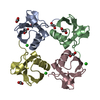

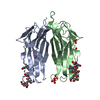


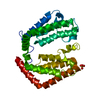
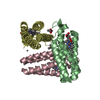
 PDBj
PDBj



